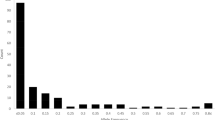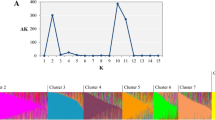Abstract
The extent of and accessibility to genetic variation in a large germplasm collection are of interest to biologists and breeders. Construction of core collections (CC) is a favored approach to efficient exploration and conservation of novel variation in genetic resources. Using 4,310 Chinese accessions of Oryza sativa L. and 36 SSR markers, we investigated the genetic variation in different sized sub-populations, the factors that affect CC size and different sampling strategies in establishing CC. Our results indicated that a mathematical model could reliably simulate the relationship between genetic variation and population size and thus predict the variation in large germplasm collections using randomly sampled populations of 700–1,500 accessions. We recommend two principles in determining the CC size: (1) compromising between genetic variation and genetic redundancy and (2) retaining the main types of alleles. Based on the most effective scheme selected from 229 sampling schemes, we finally developed a hierarchical CC system, in which different population scales and genetic diversities allow a flexible use of genetic resources. The CC, comprising 1.7% (932) of the accessions in the basic collection, retained more than 85% of both the SSR and phenotypic variations. A mini core collection, comprising 0.3% (189) of the accessions in the basic collection, retained 70.65% of the SSR variation and 76.97% of the phenotypic variation, thus providing a rational framework for intensive surveys of natural variation in complex traits in rice genetic resources and hence utilization of variation in rice breeding.






Similar content being viewed by others
References
Allard RW (1992) Predictive methods for germplasm identification. In: Stalker HT, Murphy JP (eds) Plant breeding in the 1990’s. CAB International, Wallingford, pp 119–146
Bataillon TM, David JL, Schoen DJ (1996) Neutral genetic markers and conservation genetics: simulated germplasm collections. Genetics 144:409–417
Bisht IS, Mahajan RK, Lokknathan TR, Agrawal RC (1998) Diversity in Indian sesame collection and stratification of germplasm accessions in different diversity groups. Genet Resour Crop Evol 45:325–335
Brown AHD (1978) Isozymes, plant population genetic structure and genetic conservation. Theor Appl Genet 52:145–157
Brown AHD (1989a) The case for core collections. In: Brown AHD, Frankel OH, Marshall DR, Williams JT (eds) The use of plant genetic resources. Cambridge University Press, Cambridge, pp 136–156
Brown AHD (1989b) Core collections: a practical approach to genetic resources management. Genome 31:818–824
Charmet G, Balfourier F (1995) The use of geostatistics for sampling a core collection of perennial ryegrass populations. Genet Resour Crop Evol 42:303–309
Crossa J, Hernandez M, Bretting P, Eberhart SA, Taba S (1993) Statistical genetic considerations for maintaining germplasm collections. Theor Appl Genet 86:637–678
Ellis PR, Pink DAC, Phelps K, Jukes PL, Breeds SE, Pinnegar AE (1998) Evaluation of a core collection of Brassica oleracea accessions for resistance to Brevicoryne brassicae, the cabbage aphid. Euphytica 103:149–160
Falush D, Stephens M, Pritchard JK (2003) Inference of population structure using multilocus genotype data: linked loci and correlated allele frequencies. Genetics 164:1567–1587
FAO (1997) Report on the State of the World’s Plant Genetic Resources for Food and Agriculture. Food and Agriculture Organization of the United Nations, Rome
Franco J, Crossa J, Warburton ML, Taba S (2006) Sampling strategies for conserving maize diversity when forming core subsets using genetic markers. Crop Sci 46:854–864
Frankel OH, Brown AHD (1984) Plant genetic resources today: a critical appraisal. In: Holden JHW, Williams JT (eds) Crop genetic resources: conservation and evaluation. Allen and Unwin, London, pp 249–257
Frankel OH, Brown AHD, Burdon JJ (1995) The conservation of plant biodiversity. Cambridge University Press, UK
Gouesnard B, Bataillon TM, Decoux G, Rozale C, Schoen DJ, David JL (2001) MSTRAT: an algorithm for building germplasm core collections by maximizing allelic or phenotypic richness. J Hered 92:93–94
Holbrook CC, Timper P, Xue HQ (2000) Evaluation of the core collection approach for identifying resistance to Meloidogyne arenaria in peanut. Crop Sci 40:1172–1175
Hyams D (2003) CurveExpert 1.3. A comprehensive curve fitting system for windows. http://curveexpert.webhop.net/
Kashi Y, King DG (2006) Simple sequence repeats as advantageous mutators in evolution. Trends Genet 22:253–259
Kim KW, Chung HK, Cho GT, Ma KH, Chandrabalan D, Gwag JG, Kim TS, Cho EG, Park YJ (2007) PowerCore: a program applying the advanced M strategy with a heuristic search for establishing core sets. Bioinformatics 23:2155–2162
Li ZC, Zhang HL, Zeng YW, Yang ZY, Shen SQ, Sun CQ, Wang XK (2002) Studies on sampling strategies for establishment of core collection of rice landrace in Yunnan, China. Genet Resour Crop Evol 49:67–74
Li ZC, Zhang HL, Cao YS, Qiu ZE, Wei XH, Tang SX, Yu P, Wang XK (2003) Studies on the sampling strategy for primary core collection of Chinese indigence. Acta Agron Sin 29:20–24
Liu K, Muse S (2004) PowerMarker: new genetic data analysis software, version 2.7. http://www.powermarker.net/
Malvar RA, Butron A, Alvarez A, Ordas B, Soengas P, Revilla P, Ordas A (2004) Evaluation of the European Union maize landrace core collection for resistance to Sesamia nonagrioides (Lepidoptera: Noctuidae) and Ostrinia nubilalis (Lepidoptera: Crambidae). J Econ Entomol 97:628–634
Morgan PH, Mercer LP, Flodin NW (1975) A general model for nutritional responses of higher organisms. Proc Natl Acad Sci USA 72:4327–4331
Noirot M, Hamon S, Anthony F (1996) The principal component scoring: a new method of constituting a core collection using quantitative data. Genet Resour Crop Evol 43:1–6
Oka HI (1988) Origin of cultivated rice. Jnp. Sci. Soc. Press, Tokyo
Panaud O, Chen XL, McCouch SR (1996) Development of microsatellite markers and characterization of simple sequence length polymorphism (SSLP) in rice (Oryza sativa L.). Mol Gen Genet 252:597–607
Peeters JP, Martinelli JA (1989) Hierarchical cluster analysis as a tool to manage variation in germplasm collections. Theor Appl Genet 78:1142–1148
Qi YW (2007) Analysis of the genetic diversity of the rice cultivars (Oryza sativa L.) using SSR and HD1, HD3a gene. PhD Dissertation, China Agricultural University, Beijing
Saghai-Maroof MA, Soliman KM, Jorgensen RA, Allard RW (1984) Ribosomal DNA spacer length polymorphism in barley: mendelian inheritance, chromosomal location and population dynamics. Proc Natl Acad Sci USA 81:8014–8018
Schoen DJ, Brown AHD (1993) Conservation of allelic richness in wild crop relatives is aided by assessment of genetic markers. Proc Natl Acad Sci USA 90:10623–10627
Spagnoletti PLZ, Qualset CO (1993) Evaluation of five strategies for obtaining a core subset from a large genetic resource collection of durum wheat. Theor Appl Genet 87:295–304
Tautz D, Renz M (1984) Simple sequences are ubiquitous repetitive components of eukaryotic genomes. Nucleic Acids Res 12:4127–4138
van Hintum ThJL, Brown AHD, Spillane C, Hodgkin T (2000) Core collections of plant genetic resources. IPGRI Technical Bulletin No. 3. International Plant Genetic Resources Institute, Rome, Italy
Wang MX, Zhang HL, Zhang DL, Qi YW, Fan ZL, Li DY, Pan DJ, Cao YS, Qiu ZE, Yu P, Yang QW, Wang XK, Li ZC (2008) Genetic structure of Oryza rufipogon Griff. in China. Heredity 101:527–535
Yonezawa K, Nomura T, Morishima H (1995) Sampling strategies for use in stratified germplasm collections. In: Hodgkin T, Brown AHD, van Hintum ThJL, Morales EAV (eds) Core collections of plant genetic resources. IPGRI, Wiley, Baffins Lane, pp 35–54
Zhang HL, Sun JL, Wang MX, Liao DQ, Zeng YW, Shen SQ, Yu P, Mu P, Wang XK, Li ZC (2007) Genetic structure and phylogeography of rice landraces in Yunnan, China revealed by SSR. Genome 51:72–83
Zhang DL, Zhang HL, Wang MX, Sun JL, Qi YW, Wang FM, Wei XH, Han LZ, Wang XK, Li ZC (2009) Genetic structure and differentiation of Oryza sativa L. in China revealed by microsatellites. Theor Appl Genet 119:1105–1117
Acknowledgments
This study was supported by the National Basic Research Program of China (“973” Program, 2010CB125904, 2004CB117201) and the National Natural Science Foundation of China (30600388, 30871506). We thank Professor Robert A McIntosh, University of Sydney, for suggested revisions to the manuscript, and Professor Qifa Zhang (Huazhong Agricultural University), Professor Jizeng Jia (Institute of Crop Science, Chinese Academy of Agricultural Sciences) and Professor Zhensheng Li (Institute of Genetics and Developmental Biology, Chinese Academy of Sciences) for their constructive advice on the development of the core collection and on the writing of this paper, and Prof Xiangkun Wang (China Agricultural University) and Prof Lifang Hong (Beijing Academy of Agricultural and Forestry Sciences) for their advice on sampling the mini core collection.
Author information
Authors and Affiliations
Corresponding author
Additional information
Communicated by T. Tai.
H. Zhang and D. Zhang contributed equally to this work.
Electronic supplementary material
Below is the link to the electronic supplementary material.
Rights and permissions
About this article
Cite this article
Zhang, H., Zhang, D., Wang, M. et al. A core collection and mini core collection of Oryza sativa L. in China. Theor Appl Genet 122, 49–61 (2011). https://doi.org/10.1007/s00122-010-1421-7
Received:
Accepted:
Published:
Issue Date:
DOI: https://doi.org/10.1007/s00122-010-1421-7




